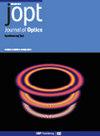A generalised entropic measure of steering using Tsallis entropies and the relationship with existent steering criteria
IF 2.7
4区 物理与天体物理
Q3 OPTICS
引用次数: 0
Abstract
EPR steering is an asymmetric quantum correlation, as such, it is an important resource for quantum information protocols, like those used in quantum key distribution that are of tremendous relevance nowadays. The security of the aforementioned protocols can be shown by using entropic uncertainty measures, which are based on quantum information quantities, among which the entropies are found. In this work, we propose an entropic measure of steering, starting from the detection of steering given in a previous entropic uncertainty relation-based criterion, as well as using a generalised entropy, the Tsallis entropies. We define the entropic measure of steering in terms of an indicator, a quantity depending on the entropies of the measurements of the system, which assigns a value to the steering content of quantum states, while also comprising the asymmetry property of steering. We investigate the properties of the proposed quantity as a measure of steering and its asymmetry and show how it can be used for specific examples. For instance, a class of noisy two-qubit states that includes the Werner states is used to demonstrate the potential of such a proposal. Furthermore, a comparison is also made with the detection of steering in these states using existing steering criteria and the amount of steering a geometric measure for the Werner state gives.利用查里斯熵对转向进行广义熵测量,以及与现有转向标准的关系
EPR 转向是一种非对称量子相关性,因此,它是量子信息协议的重要资源,例如用于量子密钥分发的协议,这些协议在当今具有重要意义。上述协议的安全性可以通过使用熵不确定性度量来证明,而熵不确定性度量是基于量子信息量的,其中就有熵。在这项工作中,我们从之前基于熵不确定性关系的准则中给出的转向检测出发,并利用广义熵,即 Tsallis 熵,提出了转向的熵度量。我们用一个指标来定义转向的熵度量,该指标是一个取决于系统测量熵的量,它为量子态的转向内容赋值,同时还包含转向的非对称特性。我们研究了所提出的量作为转向及其不对称度量的特性,并展示了如何将其用于具体实例。例如,我们用一类包含维尔纳态在内的噪声双量子比特态来证明这一提议的潜力。此外,我们还比较了使用现有转向标准对这些状态的转向检测,以及沃纳状态的几何测量所给出的转向量。
本文章由计算机程序翻译,如有差异,请以英文原文为准。
求助全文
约1分钟内获得全文
求助全文
来源期刊

Journal of Optics
OPTICS-
CiteScore
4.50
自引率
4.80%
发文量
237
审稿时长
1.9 months
期刊介绍:
Journal of Optics publishes new experimental and theoretical research across all areas of pure and applied optics, both modern and classical. Research areas are categorised as:
Nanophotonics and plasmonics
Metamaterials and structured photonic materials
Quantum photonics
Biophotonics
Light-matter interactions
Nonlinear and ultrafast optics
Propagation, diffraction and scattering
Optical communication
Integrated optics
Photovoltaics and energy harvesting
We discourage incremental advances, purely numerical simulations without any validation, or research without a strong optics advance, e.g. computer algorithms applied to optical and imaging processes, equipment designs or material fabrication.
 求助内容:
求助内容: 应助结果提醒方式:
应助结果提醒方式:


